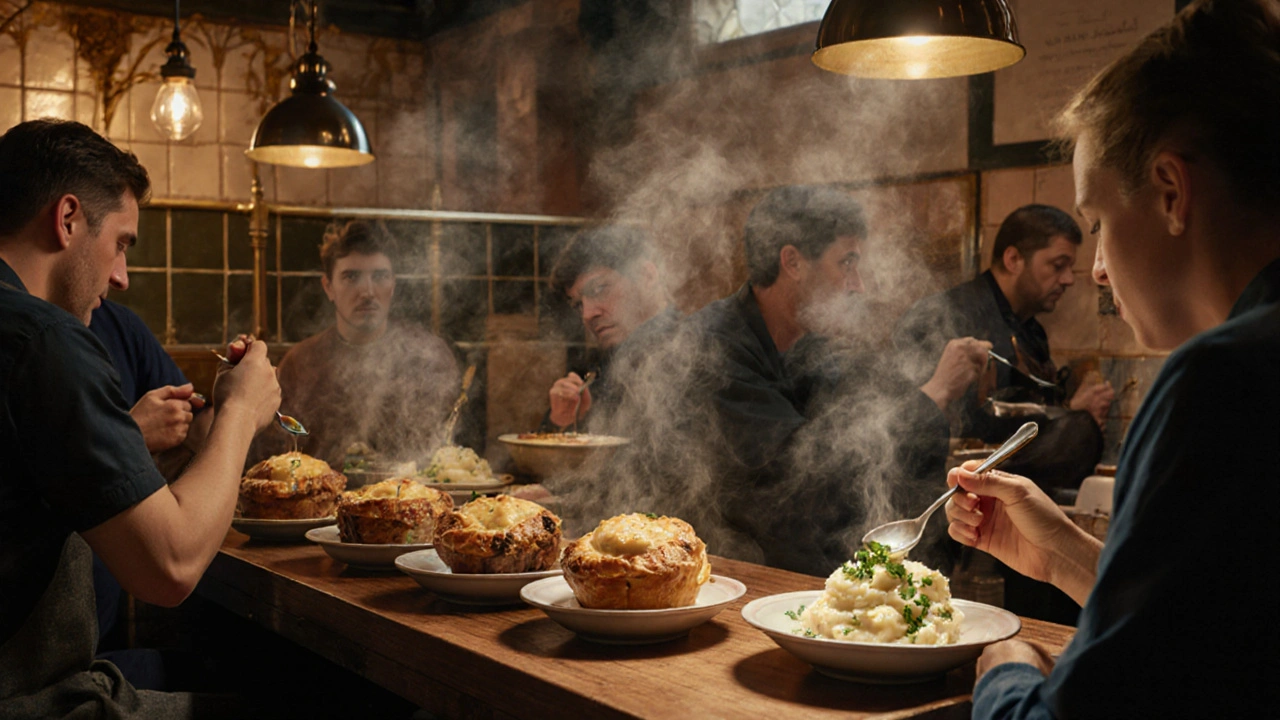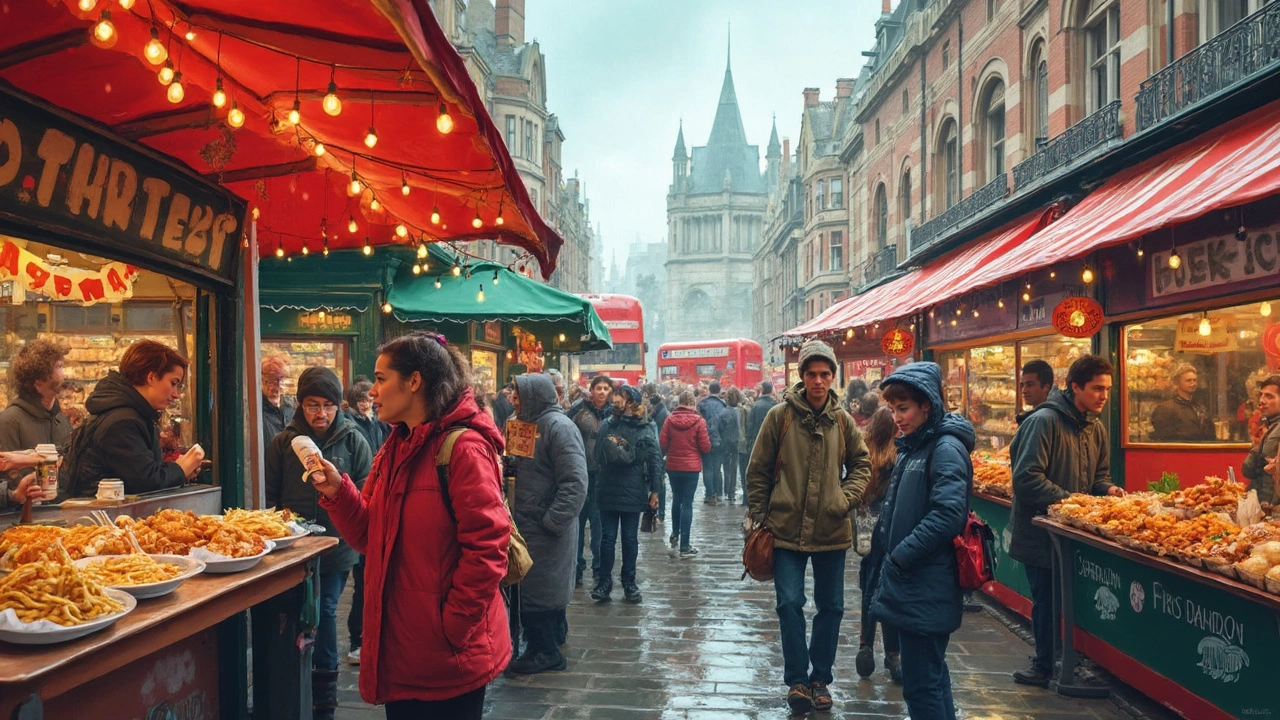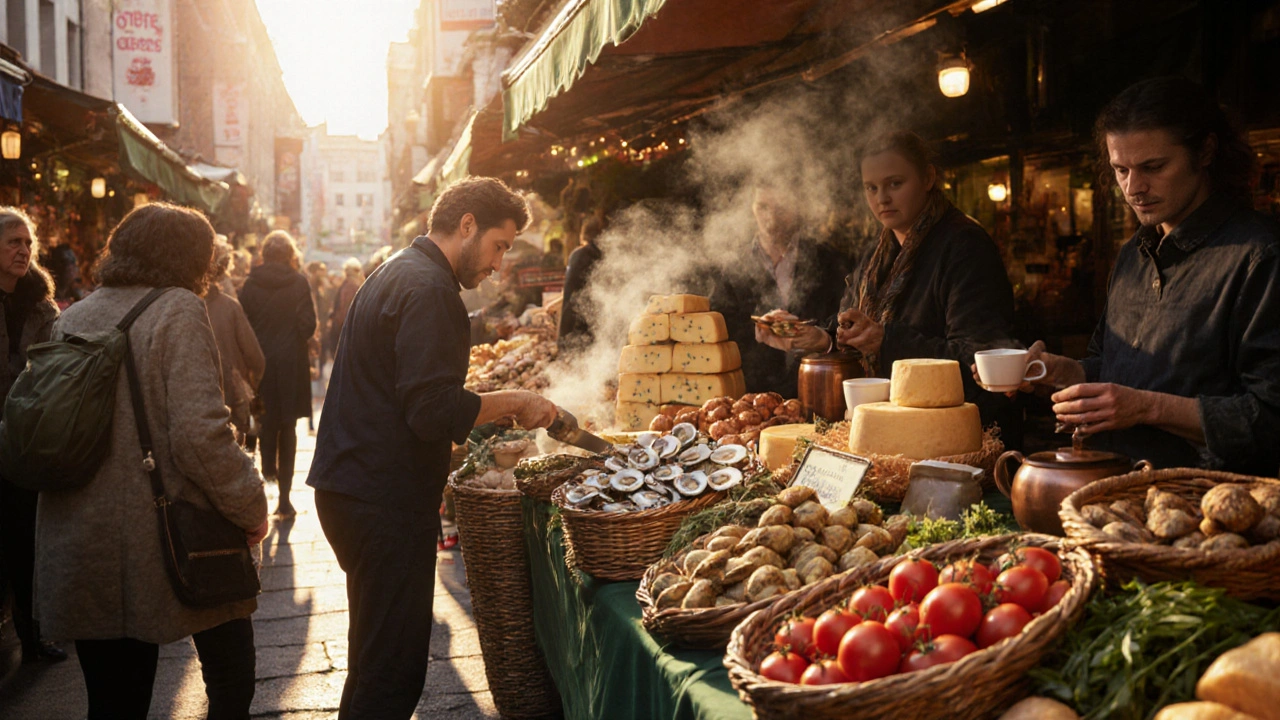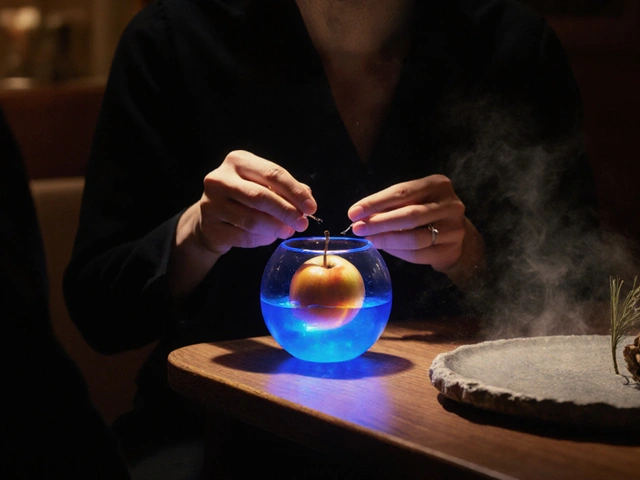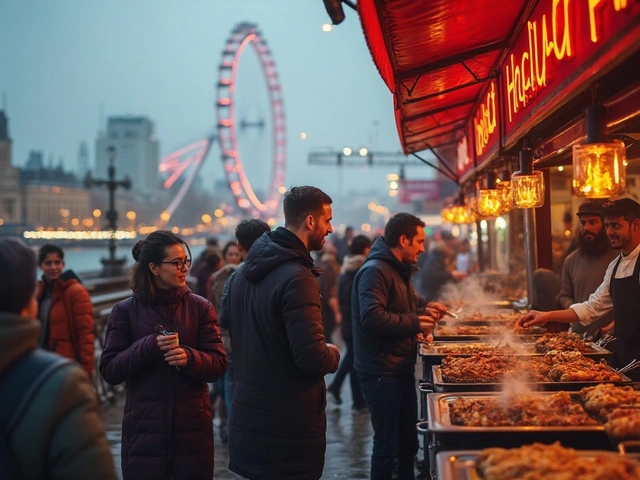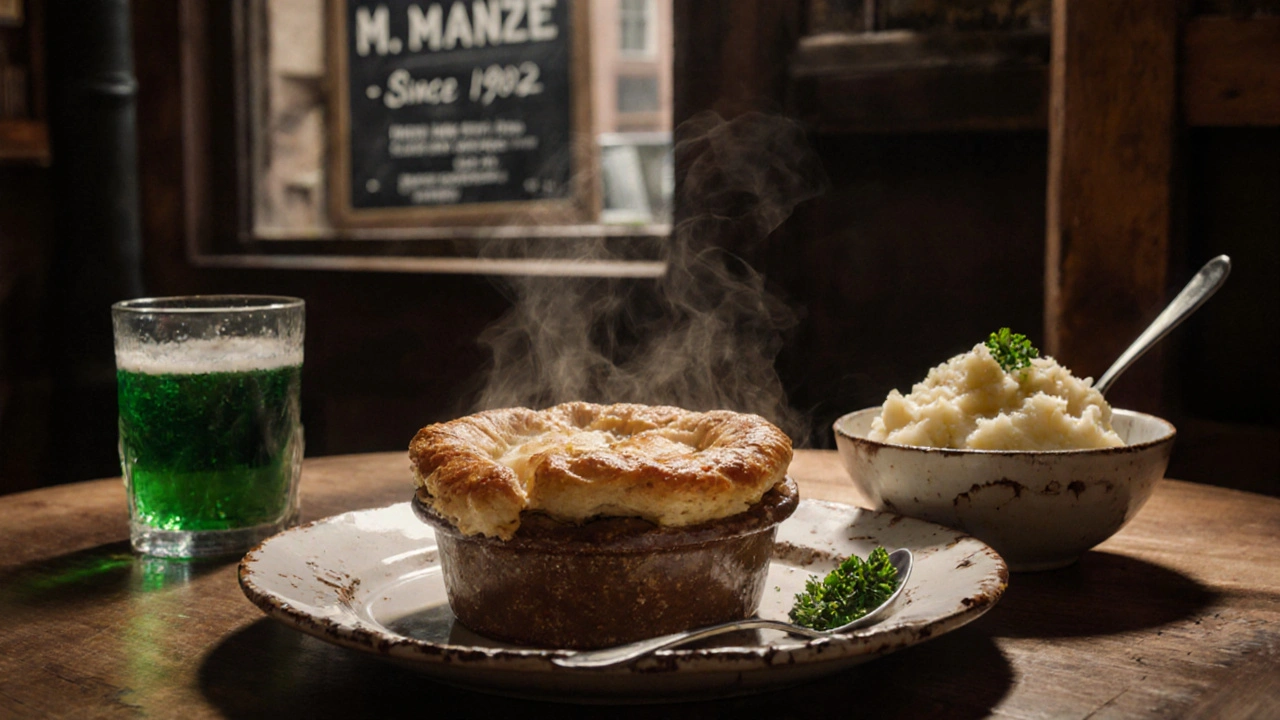
You’ve walked past dozens of food stalls, smelled roasting chestnuts near Covent Garden, and seen tourists lining up for a pie and mash. But have you actually eaten what London’s best food has to offer? This isn’t about fancy restaurants with tasting menus. This is about the real, unfiltered, mouthwatering eats that locals swear by-stuff you won’t find on a generic travel blog.
Start with the classics: pie and mash
Don’t skip this. If you only try one thing in London, make it pie and mash. It sounds simple-meat pie, mashed potatoes, and a spoonful of green parsley liquor. But the magic is in the crust: flaky, buttery, and packed with beef that’s been slow-cooked until it falls apart. Head to M. Manze in Peckham or Ellis Pie and Mash in Southwark. The parsley liquor? It’s not just gravy. It’s a broth made from the pie’s juices, parsley, and a hint of vinegar. You’ll taste the history in every bite.
Try a proper Sunday roast
Sunday roast isn’t just a meal. It’s a ritual. You’ll get tender roast beef (or chicken, lamb, or pork), crispy roast potatoes, Yorkshire pudding that puffs up like a cloud, and vegetables that still have a bite. The gravy? Thick, rich, and made from the drippings of the roast. Skip the chain pubs. Go to The Eagle in Clerkenwell or The Harrow in Little Venice. They serve it with a side of quiet charm and no rush. If you’re there on a Sunday, you’re in the right place.
Grab a jellied eel from East London
Yes, it’s weird. And yes, it’s legendary. Jellied eels are cooked eels simmered in a spiced broth, then cooled until the liquid turns into a savory jelly. It’s an old East End staple, once eaten by dockworkers for cheap protein. Try it at The Prospect of Whitby-London’s oldest riverside pub. Don’t expect a fancy presentation. It’s served in a bowl with a dash of vinegar. First bite? It’s briny, gelatinous, and oddly addictive. If you’re brave, go for it. If not, just order it to say you tried.
Sample a full English breakfast
This isn’t your hotel buffet. A real full English includes back bacon, sausage, baked beans, grilled tomato, mushrooms, black pudding (a blood sausage that’s rich and slightly metallic), fried bread, and eggs-usually sunny-side up. Skip the chains. Find a local greasy spoon like The Breakfast Club in Soho or Waffle & Co. in Notting Hill. The key? Everything is cooked fresh to order. The beans? Canned? No. They’re slow-simmered with tomatoes and herbs. The black pudding? Made in-house. This is comfort food with soul.
Walk through Borough Market and eat your way through it
Borough Market isn’t just a food market. It’s a food pilgrimage. You’ll find over 100 stalls selling everything from handmade cheeses to oysters on ice. Don’t miss the British Cheese Company-try a wedge of Montgomery Cheddar, sharp and crumbly. Grab a truffle and parmesan croissant from Flour Power. Sip on a cold brew from The Coffee Works. And yes, try the oysters-fresh, briny, and served with a squeeze of lemon. It’s the best food market in Europe for a reason.
Try a Cornish pasty
It’s not a pie. It’s a pasty. Thick, crimped pastry folded around beef, potato, swede, and onion. Originating in Cornwall, it’s been a miner’s lunch for centuries. In London, head to The Cornish Pasty Company in Covent Garden or Pasty Kitchen in Camden. The crust should be golden and sturdy enough to hold the filling without falling apart. Eat it warm. It’s the perfect handheld snack after a long day of walking.
Indulge in a sticky toffee pudding
This dessert is the reason people believe in magic. It’s a moist sponge cake made with dates, drowned in warm toffee sauce, and topped with vanilla custard or clotted cream. You’ll find it everywhere, but the best version is at The Ivy or Sketch. The sauce shouldn’t be sugary-it should be deep, buttery, and just a little salty. One bite, and you’ll understand why it’s England’s most beloved pudding.
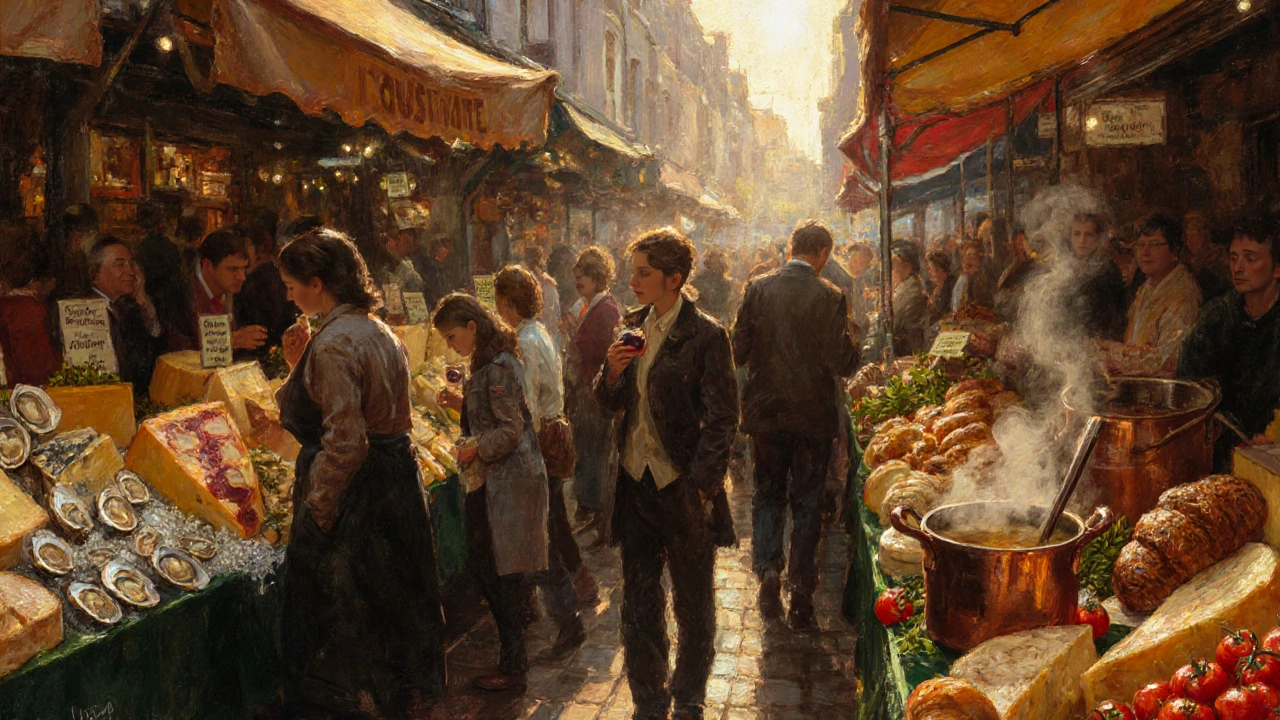
Sample a Welsh rarebit
Forget grilled cheese. Welsh rarebit is the grown-up version. Toasted bread topped with a thick, savory cheese sauce made with ale, mustard, and Worcestershire sauce. It’s melted, bubbly, and deeply comforting. Try it at The Anchor & Hope in Waterloo. It’s often served with a poached egg on top. Don’t rush it. Let the cheese cool just enough so it clings to the bread. It’s simple. It’s perfect.
Try a Balti curry
It’s not Indian. It’s Birmingham. The Balti is a spicy, sizzling curry cooked in a thin steel wok and served with naan. In London, head to Balti House in Sparkhill or Shah Jahan in Brick Lane. The key? The curry is cooked fast, over high heat, so the spices cling to the meat and vegetables. It’s served with a side of rice and a cooling raita. Don’t ask for mild. Go for medium or hot. You’ll taste the heat, the smoke, and the love.
Get a fish and chips from a chippy
Not a restaurant. A chippy. Look for a place with a line of locals. The batter should be light, crisp, and not greasy. The fish? Cod or haddock, fried fresh in beef dripping or sunflower oil. The chips? Thick-cut, fluffy inside, golden outside. Try Poppies in Southwark or The Golden Hind in Islington. Eat it with salt, vinegar, and mushy peas. No forks. Just your hands. It’s messy. It’s perfect.
Try a Scotch egg
A hard-boiled egg wrapped in sausage meat, coated in breadcrumbs, and deep-fried. Sounds basic. Tastes incredible. The best ones come from Fortnum & Mason or St. John. The sausage should be herby and juicy, not dry. The yolk should still be runny. It’s the ultimate pub snack. Grab one with a pint and call it lunch.
Sample a cream tea
It’s not just tea and scones. A proper cream tea is scones, clotted cream, and strawberry jam-eaten in that order. The cream should be thick enough to hold its shape. The jam? Real fruit, no artificial flavor. Go to The Ritz for the luxury version or The Ivy House in Richmond for the local favorite. Don’t spread the jam first. Put the cream on, then the jam. It’s tradition. And yes, it matters.
Try a sausage roll
It’s not a snack. It’s a national treasure. Flaky pastry wrapped around seasoned pork sausage. Best eaten warm. The best in London? Patisserie Valerie or The Ginger Pig. The pastry should shatter. The sausage should be juicy and full of sage. Grab two. You’ll want the second one.
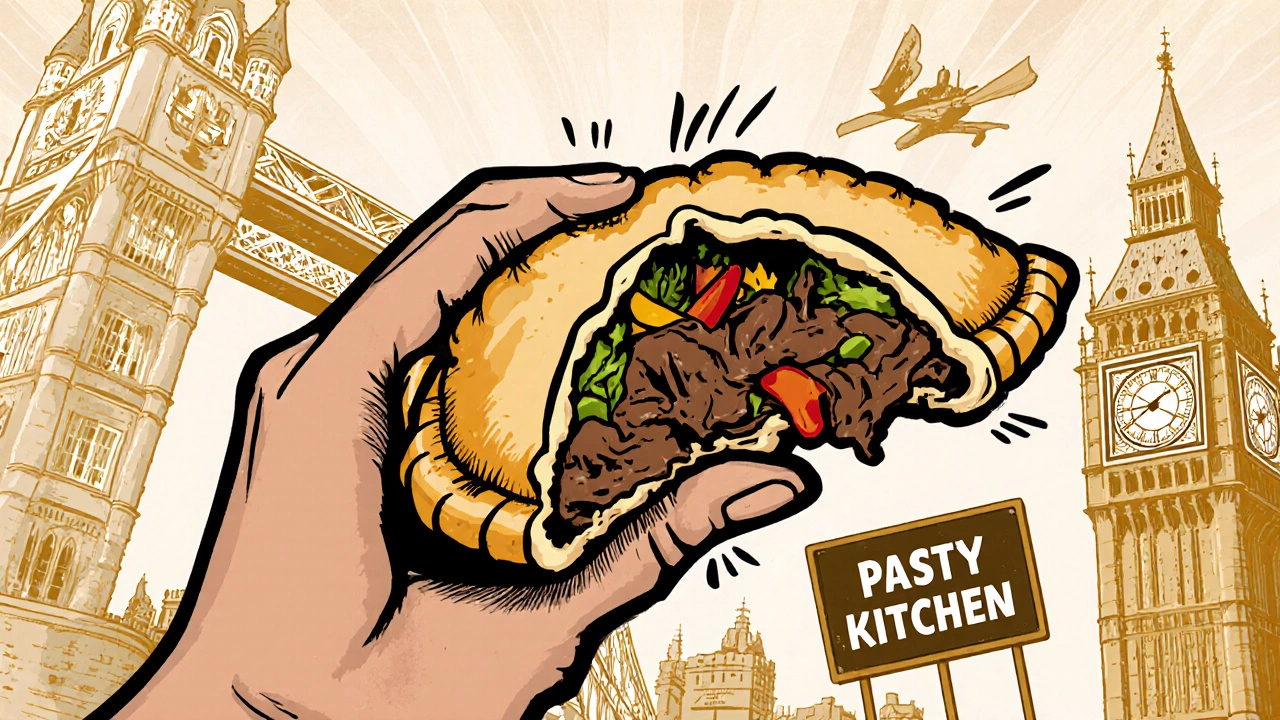
Sample a ploughman’s lunch
A pub staple: cold meats, sharp cheddar, pickled onions, crusty bread, and a side of apple. It’s the anti-fancy meal. No fuss. Just flavor. Try it at The Dove in Hammersmith or The Anchor in Bankside. The cheese should be aged. The pickles should be tangy. The bread? Thick and chewy. It’s the perfect lunch after a morning of sightseeing.
Try a bakewell tart
A sweet, almond-flavored tart with a jam base and a frangipane topping. It’s not a cake. It’s not a pie. It’s its own thing. The best version is at Fortnum & Mason or Little Miss Baker in Camden. The jam should be raspberry. The topping should be soft, nutty, and just sweet enough. Eat it with a cup of Earl Grey. It’s the kind of treat that makes you slow down.
Finish with a London fog
It’s not a weather condition. It’s a drink. A latte made with Earl Grey tea, steamed milk, and a touch of vanilla syrup. It’s creamy, floral, and soothing. You’ll find it at Bluebird in Chelsea or Monmouth Coffee in Borough Market. It’s the perfect end to a food-filled day. No sugar rush. Just calm.
Where to eat like a local
Don’t follow the tourist signs. Walk into a pub on a side street. Look for places with a chalkboard menu and no English menu. Ask the barman: “What’s good today?” They’ll point you to the real stuff. Eat where the office workers eat. Eat where the delivery drivers eat. That’s where the best food lives.
What not to do
Don’t eat at the tourist traps near Big Ben or Trafalgar Square. The fish and chips there are soggy. The pies are frozen. The tea is lukewarm. Don’t pay £25 for a “traditional” meal that’s been mass-produced. London’s best food isn’t in the guidebooks. It’s in the alleyways, the markets, the corner pubs.
Final tip: Eat slowly
London food isn’t about speed. It’s about texture, history, and flavor. Take your time. Savor the crust on the pie. Let the toffee sauce cool just enough. Listen to the crunch of the chips. This isn’t just eating. It’s experiencing a city-one bite at a time.
What is the most iconic food to try in London?
The most iconic food is pie and mash. It’s a working-class dish with deep roots in East London, featuring a meat pie, mashed potatoes, and parsley liquor. It’s simple, hearty, and unlike anything you’ll find elsewhere.
Where can I find the best fish and chips in London?
The best fish and chips are at local chippies like Poppies in Southwark or The Golden Hind in Islington. Look for places with a line of locals, fresh batter, and thick-cut chips. Avoid chains near tourist spots-they’re rarely authentic.
Is Borough Market worth visiting for food?
Absolutely. Borough Market is one of Europe’s best food markets. You’ll find fresh oysters, artisan cheeses, truffle croissants, and handmade pastries. Go early to avoid crowds, and bring cash for smaller stalls.
What’s the difference between a pasty and a pie?
A pie has a top and bottom crust and is usually baked in a dish. A pasty is folded in half, with a crimped edge, and designed to be handheld. Pasty fillings are simpler-beef, potato, swede, and onion-and it’s a Cornish specialty.
Are there vegetarian options in London’s traditional food?
Yes. Many places offer vegetarian pies, Welsh rarebit, ploughman’s lunch with cheese and pickles, and veggie sausage rolls. Borough Market has dozens of plant-based stalls. Ask for “vegetarian-friendly” options-most places are happy to accommodate.
Comments (6)
- Aditi Sonar
- November 3, 2025 AT 00:16 AM
Okay but have you seen the CCTV footage from M. Manze at 3am? 🤫 The parsley liquor isn't just broth-it's laced with secret East End herbs that make you hallucinate your grandma's voice singing sea shanties. I saw a guy cry after eating it. He said he heard his dead uncle say 'more vinegar'. 🍵😭
- Vincent Barat
- November 4, 2025 AT 21:44 PM
Let’s be clear: this list is a propaganda tool. Pie and mash? A socialist relic. The REAL British culinary identity is in the Royal Navy’s salt beef and hardtack tradition-authentic, unadulterated, and free from immigrant influences! And don’t get me started on ‘Balti curry’-that’s just Birmingham’s attempt to plagiarize Punjab. 🇬🇧🔥
- Ramesh Narayanan
- November 5, 2025 AT 20:15 PM
Correction: the jellied eel at Prospect of Whitby is indeed authentic, but the vinegar should be malt, not distilled. Also, 'black pudding' is spelled with a space: black pudding, not blackpudding. And the Yorkshire pudding at The Eagle? It's good, but not as good as the one at The Fox & Goose in Sheffield-crispier, lighter. Just saying.
- Louie B-kid
- November 7, 2025 AT 04:28 AM
Love this list! Seriously, so many people overlook how rich London’s food culture is beyond the tourist traps. The Cornish pasty? Perfect portable fuel. Sticky toffee pudding? Pure emotional comfort. And yes-Borough Market is a must. I went last month and tried the truffle croissant with a cold brew and just… cried a little. Food like this connects us. Keep sharing these gems! 🙌
- Taranveer Dhiman
- November 8, 2025 AT 05:27 AM
Let’s be honest-unless you’re dining at Fortnum & Mason with a £500 bottle of champagne and a live harpist, you’re not really experiencing London. The pie and mash? Cute. But it’s peasant food. The real elite experience? A £200 tasting menu at Sketch with edible gold leaf and a sommelier who whispers your zodiac sign before each course. 🌟💎 #FoodIsStatus
- Steven Williams
- November 8, 2025 AT 10:55 AM
Best tip: ask the barman. Always.

